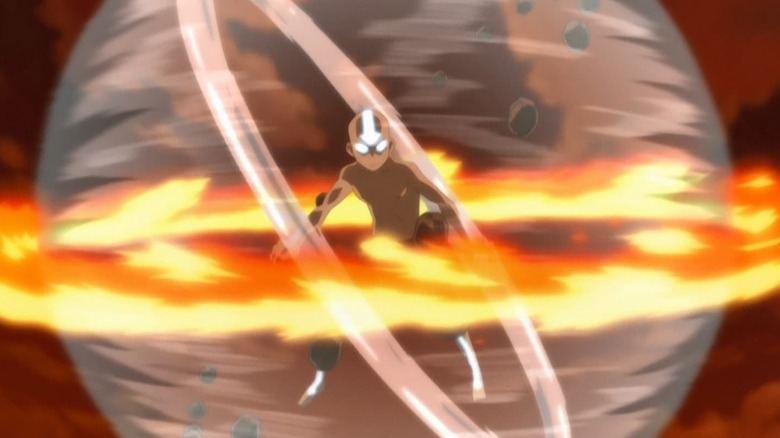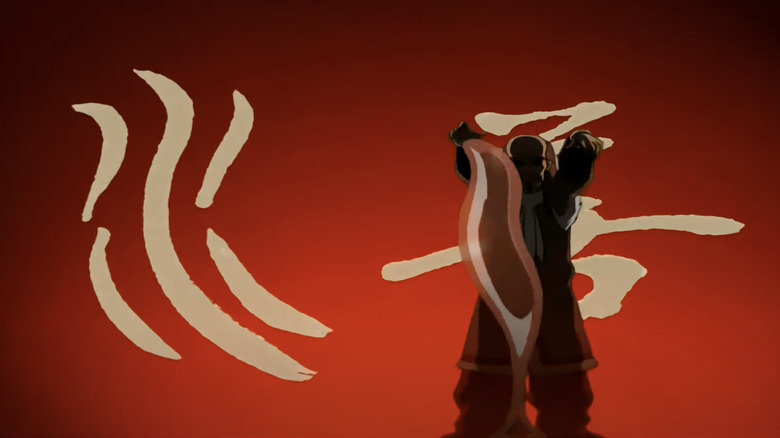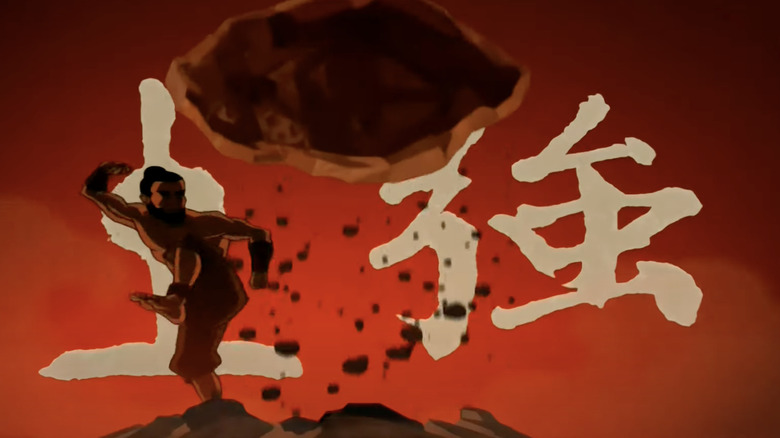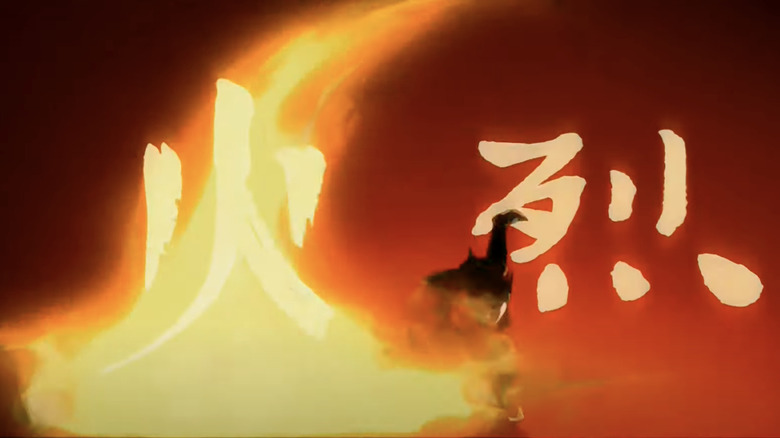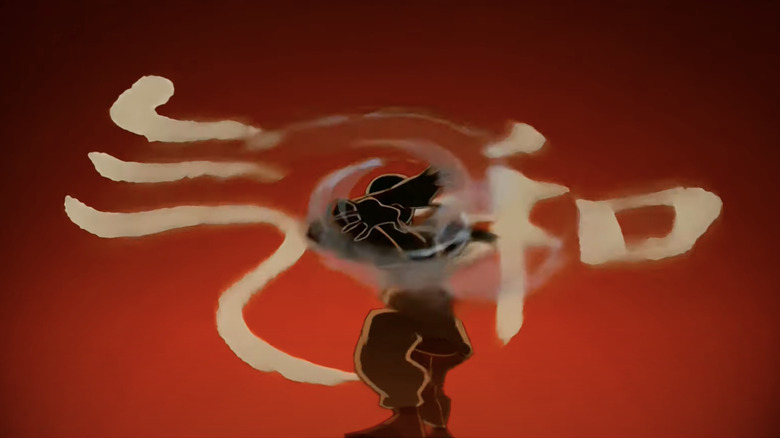The Different Bending Types In Avatar: The Last Airbender Explained
Putting it mildly, "Avatar: The Last Airbender" pulls a lot from Southeast Asian mythology and history. (The live-action version, which recently debuted on Netflix, cast actors from corresponding backgrounds with good reason.) The show can't completely escape Orientalism but at least the writers did their research.
A savior named the Avatar with a reincarnation cycle? That's adapted (and heavily simplified) from Hindu myths about gods incarnating on Earth. The Fire Nation resembles 20th-century Imperial Japan: an island-chain nation undergoing its industrial revolution and colonizing its neighbors (in this allegory, the Earth Kingdom is China; larger and more diverse but technologically behind the neighboring empire). Then there are the details of the setting, like architecture, outfits, and the in-universe writing system, which are all inspired by real-world Asian cultures. Even the show's animation is purposefully meant to resemble anime that co-creators Bryan Konietzko and Michael Dante DiMartino loved, like Hayao Miyazaki movies and "Cowboy Bebop."
"Avatar: The Last Airbender" is a fantasy show and the magic system also pulls from Eastern concepts. In the show, spiritually-attuned people can control, or bend, one of the four classical elements: Water, Earth, Fire, and Air. (This list is referenced, though not culturally exclusively, in Buddhism and Hinduism.)
The bending styles are all modeled on real Chinese martial arts too. The series' animated fight scenes were crafted with the help of the consultant Sifu Kisu, a Shaolin kung fu teacher. ("Sifu" refers to a martial arts teacher in Chinese.) Here's a rundown of the different types of bending, and some of the more advanced skills that benders can acquire.
Waterbending in Avatar: The Last Airbender
"Water is the element of change. The people of the Water Tribe are capable of adapting to many things. They have a deep sense of community and love that holds them together through anything."
The water nation is bifurcated, with two tribes living at opposite poles of the Earth: the isolationist and unified Northern Water Tribe and the less advanced Southern Water Tribe, which has been whittled down by Fire Nation raids.
Ancient Waterbenders learned to master the element by studying the Moon and how it regulates the flow of the ocean. Notice how often Katara steps backward while pulling the water into the air and then thrusts herself forward, mimicking the movements of an ocean wave. Due to this, Waterbenders are most powerful during a full Moon.
Waterbending involves control of water in all its forms. Waterbenders can control ice to make shields or stabbing weapons, as well as freezing and/or melting existing water. Waterbenders can also use the element to heal bodily injuries since water is the root of life. On the flip side, skilled Waterbenders can even control the water that exists inside living things with a dark art called Bloodbending.
Waterbending is modeled on Tai Chi, a slower-paced form that concentrates on peaceful body movements. Tai Chi is less about hitting hard and more about refining your posture and flexibility. Waterbending moves typically feature wide arm reaches and circular movements, while the bender consistently adjusts their stance to complement the direction of their upper body. It's as if the bender is tuning their body to flow like the water surrounding them. This carries over to combat, where Waterbenders rarely stay in place. Instead, they adapt to their opponent's moves, dodge them, and then are quick enough to strike back.
Earthbending in Avatar: The Last Airbender
"Earth is the element of substance. The people of the Earth Kingdom are diverse and strong. They are persistent and enduring."
The "Avatar: The Last Airbender" nations are home to many animals, most of whom are mash-ups of two real-world creatures. For instance, the enormous and blind badgermoles, who live underground and tunnel through the Earth by manipulating it. The people of the Earth Kingdom, the large mainland continent, learned their bending from badgermoles.
Like the people of the Earth Kingdom, the earth itself has diverse manifestations, existing as stone, dirt, and sand; Earthbenders can control them all. Especially skilled ones can bend more unique types of earth, such as magma (Lavabending) and certain refined metals (Metalbending).
Earthbending is the most defensive bending form. It's the only element that's a solid, not a liquid like water, ephemeral like fire, or intangible like air. Notice how the default Earthbending pose is a horse stance, where a martial artist spreads their legs apart and bends them to firm up their position. This makes you a lot harder to knock down. Earthbenders standing in place and throwing levitating rocks at their opponents is akin to projecting a punch or kick outward from a horse stance, albeit with farther reach (indeed, those are the motions that Benders use to direct the earth).
Earthbending techniques are modeled on Hung Ga, a type of kung fu that emphasizes strength, both in martial artists' stances and attacks. Unlike the flowing Tai Chi/Waterbending, Hung Ga/Earthbending concentrates on staying still and maintaining solid footing. Even when you kick, you then return to your horse stance.
If the live-action "Avatar: The Last Airbender" makes it to season 2, Toph will surely be introduced and show off some more Earthbending (and probably some Metalbending too).
Firebending in Avatar: The Last Airbender
"Fire is the element of power. The people of the Fire Nation have desire and will and the energy and drive to achieve what they want."
The people of the Fire Nation live on a chain of volcanic islands and learned Firebending from firebreathing dragons. Indeed, Firebenders are the only ones who can create their element, not merely master it; they transmute their breath into flames just like the dragons do. This means that Firebending is the most physically taxing bending style. Like with real martial arts, you need to regulate the flow of your breath or you'll tire out and lose precise control of your movements (that's why meditation is as vital to learning martial arts as kicking things is). Like fire itself, power and energy don't last long.
The purest form of fiery energy is lightning, so master Firebenders — like Ozai, Iroh, and Azula — can generate and shoot electricity from their fingertips. Some Firebenders can also create remote explosions in their line of sight (Combustionbending). As for Azula's blue flames? Despite fan conjectures that such flames are especially powerful (since blue flames burn hotter than orange ones), that was never elaborated on in the cartoon. It's just a symbol of her cold personality (since blue is ironically a cooler color than orange) and the color-coding contrasts her with Zuko.
Firebending is the most aggressive bending style, as it centers around the most dangerous and destructive element. The technique is based on Northern Shaolin kung fu (which Sifu Kisu teaches). Think of this as a more aggressive counterpart to Hung Ga. There's a similar reliance on horse stances and a balance between defending and attacking, but Northern Shaolin users are more agile about shifting stances and project their energy outward with attacks as strong as fire.
Airbending in Avatar: The Last Airbender
"Air is the element of freedom. The Air Nomads detached themselves from worldly concerns and found peace and freedom. Also, they apparently had pretty good senses of humor!"
Finally, Airbending, the bending style that gives this show its title. The Air Nomads learned their technique from Sky Bison, who can fly through the air unaided. Air Nomads had owner-pet relationships with Bison, like how Aang has Appa.
The Air Nomads (believed to be inspired by Tibetan monks) were most spiritually attuned of the Four Nations and, fittingly, the least attached to the Earth. They lived in Temples without worldly possessions or nuclear families. As shown in "The Legend of Korra," if an Airbender completely detaches themselves, they can "empty and become wind" — or take flight and thoughtlessly soar without consciously bending the air. Airbending techniques range from harmless, like levitating yourself and others with bubbles of air (as Aang calls them, air scooters), to deadly, like sucking the breath from your opponents' lungs.
Airbending is modeled on Baguazhang, a relative of Tai Chi (they are both part of the Wudangquan class, not the Shaolin school like kung fu). Baguazhang concentrates specifically on circular movements, such as walking around an imagined circle, to direct power inward. Airbending takes this to its next step with users being able to spin through the air.
"Avatar: The Last Airbender" is streaming on Netflix (both the original and the remake).
